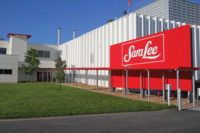Increase efficiency. Improve product handling characteristics. Meter ingredients or cleaning chemicals more accurately. Cut maintenance time and downtime. Decrease energy usage. All of these actions can decrease costs and improve your bottom line. And, you’d probably like to do all of them with the selection of the right pump.
Tech Update - Pumps
Look before you leap into pump selection
While there may be more than one pump solution for a specific application, it pays to do some homework first to find the most efficient solution.

Arla Foods Engineering Manager Per Hansen looks at Alfa Laval pumps with Tetra Pak’s Torben Bertelsen in one of Europe’s largest mozzarella cheese production facilities. Up to 300 Alfa Laval pumps have helped increase production 25 percent using 2 percent more energy. Source: Alfa Laval.

Fristam centrifugal pumps in service at a brewery can handle applications from water and CIP to wort, mash and finished beer. Source: Fristam.

Diaphragm pumps, such as Wilden’s Hygienic Series AODD, move product safely without damage, and can deadhead and run dry. Source: Pump Solutions Group.

Luigi Girotto, Morris National general manager of engineering and maintenance, inspects the SPX Universal Series I PD pump used in the Nutffles chocolate enrobing system. Switching to the pump saved labor and cut downtime. Source: SPX Flow Technology.

Moyno sanitary pumps use progressive cavity technology to provide non-pulsating, metered flows of meat products, beer and wine, fats and oils, dairy products, sauces and jams. Source: Moyno.

The Watson-Marlow Model 520 peristaltic pump can be used to meter dyes, flavors and vitamins into food and beverage products. Source: Watson-Marlow Pumps Group.


